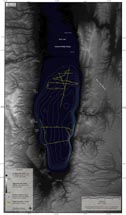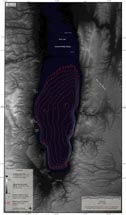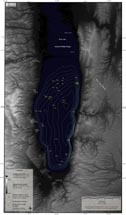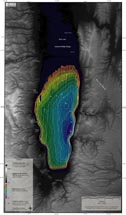Geophysical Surveys of Bear Lake, Utah-Idaho, September, 2002, OFR 03-150
|
OF 03-150 Home CD-ROM Contents Project Description GIS Data Contacts |
MethodsClick on each figure below to view larger
image. Click on figure number to go to figure-caption page for links
to images in PDF format and for further explanation of the images.
The seismic-reflection, sidescan-sonar, and bathymetric data were acquired using an Edgetech 424 chirp subbottom profiler, an Edgetech DF-1000 dual-frequency (100/500 kHz) sidescan-sonar, and an SEA Submetrix Series 2000 swath bathymetry sonar (234 kHz) systems, respectively.
Sidescan-sonar data (Figure 3) were acquired at a 0.125 second ping rate, yielding a 400 m swath. These data were logged
Bathymetric data were acquired at a 0.133 second ping rate and logged at a 2K sample rate using the SEA RTS2000 acquisition software. A TSS DMS2-05 Motion Reference Unit (MRU) mounted directly above the Submetrix Series 2000 transducers measures all motion (pitch, roll, heave, and yaw) of the vessel.
Precise measurements were taken prior to survey operations to record the offsets between the navigation antenna and the MRU (the MRU is treated as the reference location for all systems). The Wide Area Augmentation System (WAAS) was utilized for navigation, yielding horizontal accuracies of less than 3 meters. Bathymetric swath width varied as a function of depth, ranging from ~20 times water depth in 10 meter water depth and shallower, to ~4-5 times water depth in 40 meter water depth and deeper (Figure 5). The
To view files in PDF format, download free copy of Adobe Acrobat Reader www.adobe.com/products/acrobat/alternate.html. |
Title Page / Contents / Project Description / GIS Data / Contacts
[an error occurred while processing this directive]



